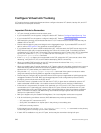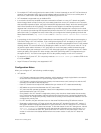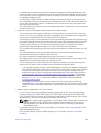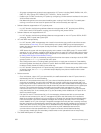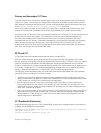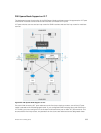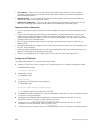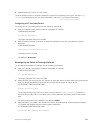(DR) if they are incorrectly hashed. In addition to being first-hop or last -hop routers, the peer node can
also act as an intermediate router.
On a VLT-enabled PIM router, if any PIM neighbor is reachable through a Spanned Layer 3 (L3) VLAN
interface, this must be the only PIM-enabled interface to reach that neighbor. A Spanned L3 VLAN is any
L3 VLAN configured on both peers in a VLT domain. This does not apply to server-side L2 VLT ports
because they do not connect to any PIM routers. These VLT ports can be members of multiple PIM-
enabled L3 VLANs for compatibility with IGMP.
To route traffic to and from the multicast source and receiver, enable PIM on the L3 side connected to
the PIM router using the ip pim sparse-mode command.
Each VLT peer runs its own PIM protocol independently of other VLT peers. To ensure the PIM protocol
states or multicast routing information base (MRIB) on the VLT peers are synced, if the incoming interface
(IIF) and outgoing interface (OIF) are Spanned, the multicast route table is synced between the VLT peers.
To verify the PIM neighbors on the VLT VLAN and on the multicast port, use the show ip pim
neighbor
, show ip igmp snooping mrouter, and show running config commands.
You can configure virtual link trunking (VLT) peer nodes as rendezvous points (RPs) in a Protocol
Independent Multicast (PIM) domain.
If the VLT node elected as the designated router fails and you enable VLT Multicast Routing, multicast
routes are synced to the other peer for traffic forwarding to ensure minimal traffic loss. If you did not
enable VLT Multicast Routing, traffic loss occurs until the other VLT peer is selected as the DR.
VLT Routing
Layer 2 protocols from the ToR to the server are intra-rack and inter-rack. No spanning tree is required,
but interoperability with spanning trees at the aggregation layer is supported. Communication is active-
active, with no blocked links. MAC tables are synchronized between VLT nodes for bridging and you can
enable IGMP snooping.
Because VLT ports are Layer 2 ports and not IP interfaces, VLT Unicast and VLT Multicast routing
protocols do not operate directly on VLT ports. You must add the VLT ports as a member of one or more
VLANs and assign IP addresses to these VLANs. VLT Unicast and VLT Multicast routing protocols require
VLAN IP interfaces for operation. Protocols such as BGP, ISIS, OSPF, and PIM are compatible with VLT
Unicast Routing and VLT Multicast Routing.
Spanned VLANs
Any VLAN configured on both VLT peer nodes is referred to as a Spanned VLAN. The VLT Interconnect
(VLTi) port is automatically added as a member of the Spanned VLAN. As a result, any adjacent router
connected to at least one VLT node on a Spanned VLAN subnet is directly reachable from both VLT peer
nodes at the routing level.
VLT Unicast Routing
VLT unicast routing locally routes packets destined for the L3 endpoint of the VLT peer. This method
avoids sub-optimal routing. Peer-routing syncs the MAC addresses of both VLT peers and requires two
local DA entries in TCAM. In case a VLT node is down, a timer that allows you to configure the amount of
956
Virtual Link Trunking (VLT)



